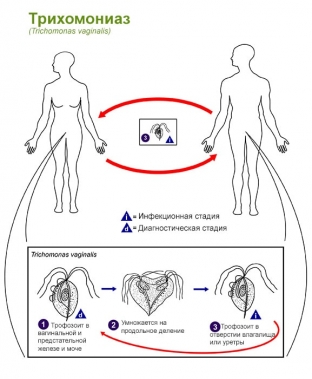Trichomoniasis is a special disease, since it is transmitted almost exclusively through sexual contact, but is most often the responsibility of gynecologists and urologists. Signs of trichomoniasis usually appear in women, and men usually get asymptomatic carriers of the infection. Usually, young patients, up to about 35 years old, turn to the doctor. Sometimes a newborn becomes infected during passage through the birth canal, but due to the characteristics of the epithelium, trichomoniasis in a baby is able to heal itself. For adult patients, it is better to start treatment as early as possible, since the treatment of trichomoniasis is difficult and lengthy.
What is the danger of trichomonas and how to recognize the signs of trichomoniasis
Trichomoniasis affects exclusively the genitourinary system – urethra, prostate, testicles with appendages in men and vagina with the urethra in women. That is why the very first signs of trichomoniasis, by which an infection can be suspected and recognized, are burning during urination, discomfort during intercourse, pain in the lower abdomen.
Trichomonas are widespread parasites, these single-celled organisms feel great in an environment without oxygen and at a temperature of about 35-37 degrees, multiplying rapidly and gaining a foothold in the cells of the mucous membranes. At the same time, they not only damage the mucous membrane, but also release waste products that poison the human body. There are reasonable suggestions that trichomoniasis can contribute to the development of diseases such as mastopathy, diabetes, certain types of allergies, and even malignant tumors.
Signs of trichomoniasis can appear quickly – a few days after infection, but more often several weeks pass. The pathogen can be easily transferred throughout the body due to the fact that it uses the enzyme hyaluronidase, which helps to penetrate into the intercellular spaces, as well as into the blood and lymph flow. Trichomonas is covered with a non-protein coat, so it is not affected by antibiotics. It is able to carry embedded bacteria and viruses inside itself – such as gonococci, herpes, candida fungus, HIV, protecting them from the effects of drugs, therefore, it is not uncommon for a patient to be diagnosed with both signs of trichomoniasis and symptoms of another sexually transmitted disease. In addition, Trichomonas is able to take the form of platelets and lymphocytes, join other microorganisms, due to which it does not fall under the action of the immune system. That is why, despite the significant arsenal of medications available to modern medicine, it is very difficult to identify signs of trichomoniasis and completely get rid of this pathogen.

Symptoms of trichomoniasis and features of the diagnosis of the disease
Invading the mucous membrane of the human genitourinary system, Trichomonas causes an inflammatory process. For the acute period of the disease in women, the following signs of trichomoniasis are characteristic:
- foamy vaginal discharge with an unpleasant odor;
- irritation and redness of the mucous membranes of the genital organs;
- rash on inner thighs;
- discomfort and burning during urination;
- discomfort during sexual intimacy;
- periodic pain in the lower abdomen.
In men, the signs of trichomoniasis usually differ. Patients are characterized by complaints of mucopurulent discharge from the urethra, itching and burning during intercourse. Since the symptoms in men more often resemble urethritis or are completely absent, it is especially difficult to diagnose the disease in them, and even with a laboratory study, Trichomonas at this stage have an atypical form and are not always correctly determined.
Thus, the signs of trichomoniasis require careful attention of the doctor in order to start treatment of the disease in a timely manner and prevent its transition to a chronic form. This is especially important for women planning a pregnancy. In this case, both partners should undergo a diagnostic examination for trichomoniasis.







Add a comment